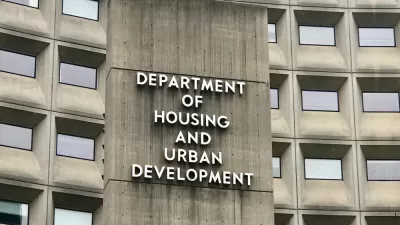After beefing up the 1968 Fair Housing Act, the feds are guiding cities to compliance.
Housing agencies nationwide are still adapting to new guidelines and more stringent enforcement issued last year by the Department Housing and Urban Development. NextCity fellow Oscar Perry Abello offers an optimistic take on how the Affirmatively Furthering Fair Housing (AFFH) rule will affect municipal housing policy.
AFFH clarifies and strengthens the 1968 Fair Housing Act, which "aims to combat segregation in American cities and tackle pockets of concentrated poverty that disproportionately impact people of color." It didn’t have much in the way of teeth in the past, Abello notes; the anti-segregation measures were seen by President Nixon and supporters as "forced integration."
Now HUD is requiring housing agencies to conduct "fair housing assessments," and intends to withdraw funding from municipalities that can’t prove their policies are non-discriminatory. That hasn’t always been the case, with failure to distribute affordable housing around cities at times resulting in "subsidized segregation."
To help cities meet these expectations, HUD is partnering with local and national non-profits to introduce a new mapping tool that visualizes geographic data on income, race and national origin, environmental quality, access to jobs and transportation, and more. "The hope was that easier and more visual access to the data, combined with deeper community engagement requirements, would start to reshape how state and local governments used their HUD resources," Abello explains.
AFFH, coupled with a Supreme Court decision expanding the definition of housing "discrimination," drew no shortage of controversy: One New York Times columnist even warned the two actions would drive middle-class whites, forced to accept affordable housing in their neighborhoods, to the Republican Party. Others worried the enforcement measures didn't go far enough to effect meaningful change.
Abello quotes experts who recommend that HUD avoid a one-size-fits all approach to implementing the new policy, instead allowing space for differing strategies based on the needs of particular communities:
Many have focused on the new rule’s potential to support more families on housing assistance with moving to wealthier neighborhoods, giving them access to better schools, cleaner air or better amenities. That may happen, but if the goal is to make sure ZIP code doesn’t determine access to fair housing and opportunity, a more balanced approach may be necessary.
Recently, for instance, HUD rejected a San Francisco plan to reserve nearly half of new affordable housing units for people already living in the neighborhood. The plan was crafted to help local black families remain in gentrifying areas of the city, but HUD categorizes all "neighborhood preference" plans as exclusionary.
More on the rules, and the non-profits helping cities to implement them, at NextCity.
FULL STORY: New HUD Rules Shouldn’t Leave Behind Disinvested Neighborhoods

Trump Administration Could Effectively End Housing Voucher Program
Federal officials are eyeing major cuts to the Section 8 program that helps millions of low-income households pay rent.

Planetizen Federal Action Tracker
A weekly monitor of how Trump’s orders and actions are impacting planners and planning in America.

Canada vs. Kamala: Whose Liberal Housing Platform Comes Out on Top?
As Canada votes for a new Prime Minister, what can America learn from the leading liberal candidate of its neighbor to the north?

Wildlife Rebounds After the Eaton Fire
Following the devastation of the Eaton Fire, the return of wildlife and the regrowth of native plants are offering powerful signs of resilience and renewal.

LA to Replace Inglewood Light Rail Project With Bus Shuttles
LA Metro says the change is in response to community engagement and that the new design will be ready before the 2028 Olympic Games.

Paris Voters Approve More Car-Free Streets
Paris Mayor Anne Hidalgo says the city will develop a plan to close 500 streets to car traffic and add new bike and pedestrian infrastructure after a referendum on the proposal passed with 66 percent of the vote.
Urban Design for Planners 1: Software Tools
This six-course series explores essential urban design concepts using open source software and equips planners with the tools they need to participate fully in the urban design process.
Planning for Universal Design
Learn the tools for implementing Universal Design in planning regulations.
Central Transportation Planning Staff/Boston Region MPO
Heyer Gruel & Associates PA
Institute for Housing and Urban Development Studies (IHS)
City of Grandview
Harvard GSD Executive Education
Toledo-Lucas County Plan Commissions
Salt Lake City
NYU Wagner Graduate School of Public Service





























